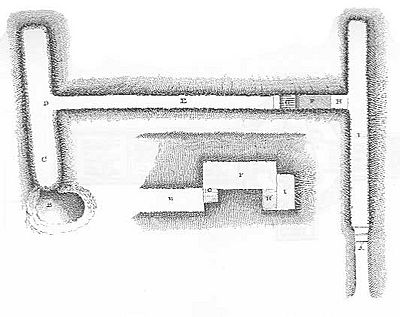Donaghmore Souterrain facts for kids
|
Uaimh Thalún an Domhnaigh Mhóir
|
|

Chart of the souterrain, from Thomas Wright's Louthiana
|
|
| Location | Donaghmore Kilcurly, Dundalk, County Louth, Ireland |
|---|---|
| Region | Castletown River Valley |
| Coordinates | 54°00′11″N 6°27′34″W / 54.002939°N 6.459380°W |
| Type | souterrain |
| History | |
| Material | stone |
| Founded | between AD 700 and 1200 |
| Cultures | Gaelic Ireland |
| Site notes | |
| Archaeologists | Etienne Ryan |
| Condition | excellent |
| Ownership | private |
| Public access | yes |
| Official name | Donaghmore Souterrain |
| Reference no. | 526 |
Donaghmore Souterrain is an amazing ancient underground tunnel system. It is found in County Louth, Ireland. This special place is also a National Monument, which means it's protected because of its history.
Contents
Where is Donaghmore Souterrain?
You can find Donaghmore Souterrain about 3.6 kilometers (2.2 miles) west of Dundalk. It is located close to a small group of houses.
What are Souterrains?
Souterrains are like secret underground passages or rooms. People in Ireland built them a very long time ago, between the 8th and 12th centuries. They were used for different things, like storing food and valuables. They also served as safe hiding places during times of danger.
History of Donaghmore Souterrain
This particular souterrain was discovered by accident in 1960. Workers were building a new house for the Louth County Council when they found it.
Later, an archaeologist named Etienne Rynne explored the souterrain. He found many interesting items. These included pieces of old pottery, a bronze pin, and a sharpening stone. He also found iron slag, which is a leftover material from making iron.
Exploring the Tunnels
The Donaghmore Souterrain is a complex network of tunnels. Its walls, floors, and ceilings are made from dry stone. This means the stones are fitted together without any mortar.
The ceilings inside the tunnels are quite tall, over 1 meter (3 feet) high. The total length of all the tunnels combined is about 80 meters (262 feet)! Most of the tunnels were dug into a type of soil called boulder clay. Some parts were also dug into a harder rock called grit.


